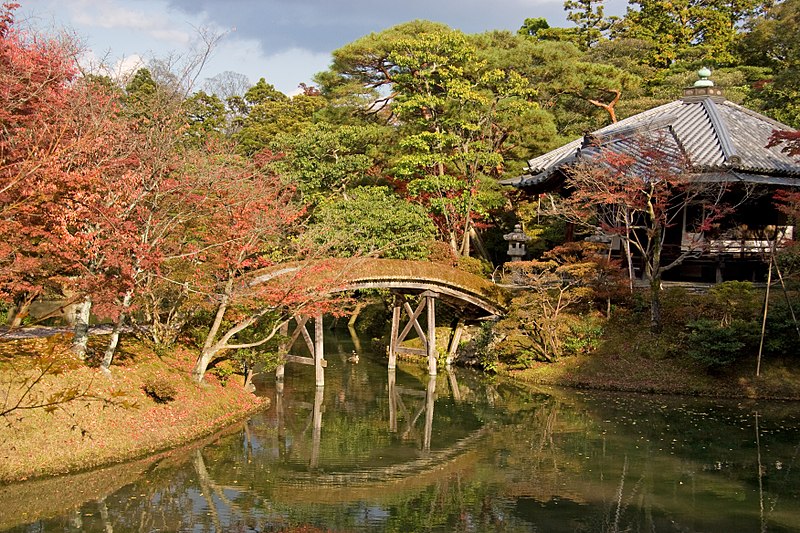
Title: Katsura Rikyu
Photographer: KimonBerlin
Medium: image/jpeg
Date: 25 November 2008
Dimensions: 3,504 x 2,336 pixels
Taken from: https://commons.wikimedia.org/wiki/File:Katsura_Rikyu_(3264703616).jpg
Description: This is a photograph of a tsuchibashi (earth-covered bridge, written 土橋) within the southwest area of the Katsura Rikyū (Katsura Villa, written 桂離宮), located by the onrin-dō (written 園林堂), a temple originally built for Prince Toshishito and Hosokawa Yusai. The tsuchibashi is built with a stable, wooden frame, its steps and platforms filled with gravel. The outer edges of the bridge are made of round, organic material, most likely moss or grass. The Katsura Rikyū is located within Kyōto (Kyoto, written 京都), a city considered the cultural capital of Japan.
Analysis: Upon looking at the architecture plan of Katsura Rikyū, the villa is built around the natural, organic structure of its environment. Rather than imposing and forcing specific manmade objects and amenities, it takes consideration of the nature it is surrounded by, such as the natural ponds and streams that sprawl across the property. It is clear, then, that the architects of this villa prioritize the value of the natural environment.
Thus, it should be noted that bridges serve as an object of transition, its purpose to take someone from one place to another. This bridge being depicted connects a piece of land reserved for the prince, yet despite the manmade influences inherent of a built temple, the connection to nature is not lost. The bridge itself is made from purely organic material, consisting of stones, dirt, wood, and grass/moss, as opposed to iron or other metals. Suppose the prince is walking across the bridge to enter the onrin-dō–he himself is walking across manmade objects, yet those objects are intertwined and embedded with nature in such a way that the architecture almost seems to blend in with its environment, making one remember that they must live with nature, and not abuse nor take away from it.
Arcs are also quite universal bridge shapes, not a Japan-specific design. Yet, it should still be noted that the architects deliberately chose an arch-shape for the tsuchibashi, and did not choose a flat bridge, instead. Thus, its reflection in the water would most certainly form a circle, or ensō (enso, written 円相)–a shape in Buddhism that is attributed with infinity, eternity, and enlightenment. One staring at such a symbol with an important meaning, one that is created with the reflective nature of water, may cause oneself to enter a reflective or meditative state. It is also perhaps meaningful to note that the Katsura Villa was created with the action of moon-viewing in mind. The moon is also one of the meanings one could derive from the Zen ensō shape.
Sources:
https://www.flickr.com/photos/jpellgen/3682186458
http://kyoto.asanoxn.com/places/katsura_matsuo/katsura/groundplanKatsura.htm
http://kyoto.asanoxn.com/places/katsura_matsuo/katsura/phkrk220.htm
https://modernzen.org/enso-htm/
https://web.archive.org/web/20141014103115/http://japantravel-guide.com/tag/prince-hachijo-toshihito